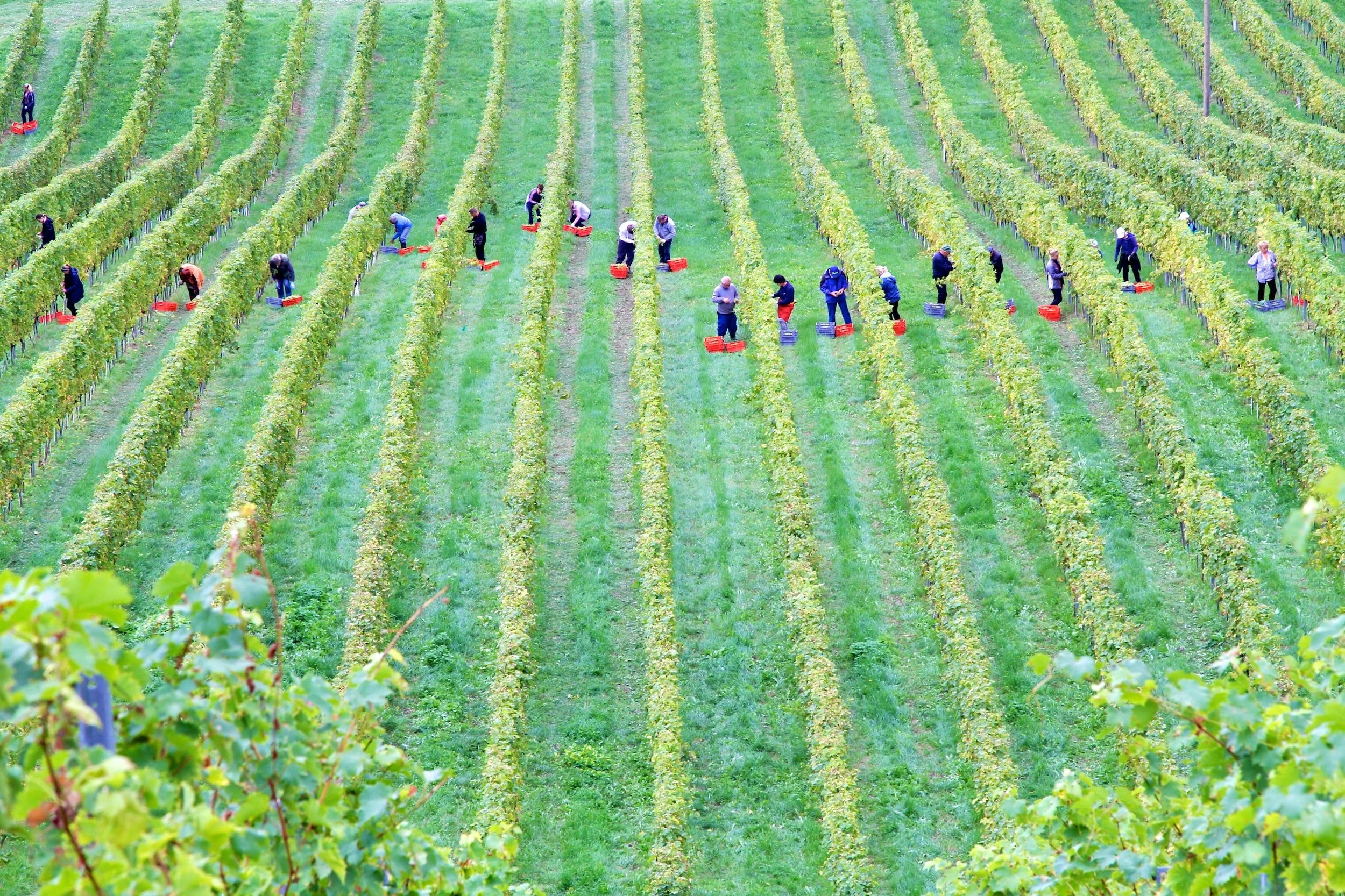Blog By: Emily Riggs
In 2021 the agricultural industry consisted of 3.3 million jobs in the United States alone.[i] Employment in agriculture and food-related industries also supports an additional 18.5 million jobs, which makes up 10.5 percent of the entire U.S. employment market.[ii]
However, there has recently been a decline in the number of farms in the United States as well as in the number of people working in this industry.[iii] The National Agriculture Statistical Service’s Farm Labor Survey reported a 73 percent decline in self-employed and family farmworkers over 50 years between 1950 to 2000.[iv] There was also a 52 percent decline in the number of hired farmhands.[v] This downward trend has continued within the last twenty years and in 2018 alone.[vi]
This decrease in labor presents the question of whether, within the next 50 years, we will have enough labor to supply food to every community across the United States. One U.S. farm can feed approximately 166 people annually.[vii] Although the production has not been decreasing, the United States population has continued to increase rapidly, in fact, the global population is expected to grow by 2.2 billion people by 2050.[viii] This means that the world’s farmers will need to produce 70 percent more to keep up with the population growth.[ix] With this estimated industry growth, also comes the question of whether the United States labor market will have enough response to meet these needs, or if we are going to have to continue to outsource the majority of these jobs.
One proposed solution is to adopt automated or smart farming techniques.[x] However, it would take the United States years or even decades to make this switch,[xi] and this delay would only increase present issues regarding the labor shortage and reliance on other countries to import food while the transition is in progress. Additionally, the reliance on Foreign-born workers, which accounts for 48.9 percent of all the agricultural workers in the United States, could also present issues.[xii] Such issues were seen during the start of the pandemic when to prevent the spread of the coronavirus the United States Department of State temporarily suspended the H-2A visa program.[xiii] This caused many farm operators who rely heavily on immigrant labor to be unable to meet production needs.[xiv] The labor shortage within the agricultural industry has become increasingly noticeable as the COVID-19 pandemic has lingered and needs to be addressed before it leads to major food shortages within our communities.[xv]
At the end of the day, to avoid devasting halts on production Congress needs to address the increasing labor shortage. One way to address this issue while balancing the United States' independence of production and the available labor market, is to revamp the H-2A visa program and begin implementing advanced technologies.[xvi] One major change would be to allow a path to citizenship for immigrants through the H-2A program.[xvii] Many say that implementing this bill would drastically improve the working conditions for millions of farmworkers and their families all around the United States[xviii] The hope is that with legal immigration status or citizenship foreign-born farmworkers and their families will no longer be afraid of being arrested or deported.[xix] Without the constant fear of deportation, these individuals would be able to speak up about abuse and mistreatment on the job.[xx] Advocates for this act state that these individuals would continue to work in these positions with less exploitation and would therefore ultimately improve the United States agriculture and food systems.[xxi]
Additionally, to ensure ethical treatment of foreign workers, Congress needs to empower agencies to enforce the hiring of documented workers, educate these workers on their rights, and implement stricter punishments for employers that mistreat workers. Without implementing changes in these areas, the mistreatment of foreign workers will continue and the decline in agriculture will go unchecked and could potentially allow for major issues in the supply of food across our nation.
[i] Ag and Food Sectors and the Economy, U.S Dep’t Agric. Econ. Rsch. Serv. (Jan. 26, 2023), https://www.ers.usda.gov/data-products/ag-and-food-statistics-charting-the-essentials/ag-and-food-sectors-and-the-economy/ [https://perma.cc/V29K-622W].
[ii] Id.
[iii] The impact of the farm labor shortage on the United States agriculture, AGAmerica Lending (June 28, 2022), https://agamerica.com/blog/the-impact-of-the-farm-labor-shortage/ [https://perma.cc/98PR-EU2X].
[iv] Id.
[v] Id.
[vi] Id.
[vii] Fast Facts About Agriculture & Food, Am. Farm Bureau, https://www.fb.org/newsroom/fast-facts (last visited Apr. 16, 2023) [https://perma.cc/6DLB-PSJJ].
[viii] Id.
[ix] Id.
[x] Kim Chipman, Farm Labor Crunch Leads U.S. Produce Growers to Turn to Robots, Bloomberg L. (Apr. 15, 2021, 3:26 PM), https://www.bloomberg.com/news/articles/2021-04-15/farm-labor-crunch-leads-u-s-produce-growers-to-turn-to-robots#xj4y7vzkg [https://perma.cc/B8CK-AYQE].
[xi] Joe Devanesan, The essential journey from farm to automated smart farm, Tech. HQ (Feb 4. 2022), https://techhq.com/2022/02/the-essential-journey-from-farm-to-an-automated-smart-farm/ [https://perma.cc/QMX2-9BBG].
[xii] Immigration and Agriculture, New Am. Econ. (Aug. 16, 2021), https://research.newamericaneconomy.org/report/immigration-and-agriculture/ [https://perma.cc/U6RD-7639].
[xiii] Caius Z. Willingham & Silva Mathema, Protecting Farmworkers From Coronavirus and Securing the Food Supply, CAP (Apr. 23, 2020), https://www.americanprogress.org/article/protecting-farmworkers-coronavirus-securing-food-supply/ [https://perma.cc/Y7BT-M9SF].
[xiv] Id.
[xv] See generally Jeff Luckstead, Rodolfo Nayga, Jr., & Heather Snell, Labor Issues in the Food Supply Chain Amid the COVID‐19 Pandemic, Nat’l Libr. of Med. (Oct. 01, 2020), https://www.ncbi.nlm.nih.gov/pmc/articles/PMC7646642/ [https://perma.cc/7NQU-KQAR].
[xvi] Devanesan, supra note xi; Curt Covington, Immigration reform can ease farm labor shortages, The Hill (Apr. 27, 2022, 11:00 AM), https://thehill.com/opinion/immigration/3467527-immigration-reform-can-ease-farm-labor-shortages/ [https://perma.cc/LVV2-B8W8].
[xvii] Covington, supra note xvi.
[xviii] Fact Sheet: United States Citizenship Act of 2021: A Bill to Protect Workers and Create a Path to Citizenship
for 11 Million Undocumented Immigrants, FARMWORKER JUST. (Feb. 2021), https://www.farmworkerjustice.org/wp-content/uploads/2021/02/FJ-FactSheet-United States-Citizenship-Act-2021.pdf [https://perma.cc/GPX5-PRFE].
[xix] Id.
[xx] Id.
[xxi] Id.



